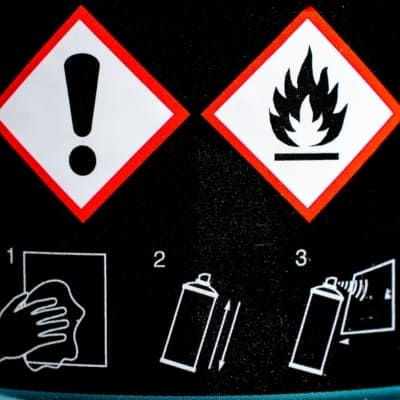Acrylic paints are popular among artists and DIY experts because of their vibrant colors, quick drying time, and adaptability. When it comes to safety there is a question that arises. Is Acrylic Paint Flammable?
The flammability of acrylic paint isn’t a straightforward “yes” or “no”. Acrylic paint doesn’t catch fire easily, but certain parts/chemical components can be flammable.
This discussion will explore the flammability and safety of acrylic paint. So, here’s what you need to remember to use acrylic paint safely.

Table of Contents
- Is Paint Flammable Or Combustible?
- Is acrylic paint flammable?
- Is Acrylic Paint Flammable When Dry?
- How Does Acrylic React To Fire?
- Ignition Temperature:
- Combustion:
- Dripping
- Rapid Spread
- Smoke and Toxic Fumes
- Self-Extinguishing
- Are Acrylic Paint Fumes Flammable?
- How long do acrylic paint fumes last?
- Is Acrylic Latex Paint Flammable?
- Is Acrylic Enamel Paint Flammable?
- Is acrylic sealer flammable?
- Is acrylic lacquer flammable?
- Acrylic paint safety tips for painting
- 1. Ventilation
- 2. Use Safety Gear
- 3. Avoid Mixing with Acidic Substances
- 4. No Eating, Drinking, or Smoking
- 5. Avoid Flammable Materials
- 6. No Smoking Near Paint
- 7. Proper Disposal
- Conclusion On is acrylic flammable:
- FAQ
- At What Temp Does Acrylic Paint Burn?
- Is Acrylic Paint Toxic?
- Martina Hitchcock
Is Paint Flammable Or Combustible?
Paint can exhibit both flammable and combustible characteristics, depending on its composition and properties. Flammable paints typically contain solvents like acetone or mineral spirits, which are highly volatile and can easily ignite when exposed to a flame, spark, or heat source. Artists and professionals working with flammable paints need to be cautious and adhere to safety guidelines to prevent acrylic painting fire hazards.
On the other hand, most common household paints, such as latex or water-based paints, are considered combustible rather than flammable. While they can burn and support combustion, they have a higher ignition point than flammable substances. Water-based paints primarily consist of water, which is not highly flammable. However, they can still burn under certain conditions, so proper storage and usage are essential.
It’s important to note that the classification of paint as flammable or combustible depends on its specific ingredients and their flash point, which is an indicator of flammability.
Artists, painters and individuals handling paint should refer to the manufacturer’s material safety data sheet to determine whether the paint is flammable or not. If the flash point for paint is at or below 140°F (60°C), it is considered a flammable liquid and may have restrictions on transportation, such as in airline baggage. Check out the chart of flammability of paint below:
| Type of Paint | Is Paint Flammable When Wet | Is Paint Flammable When Dry | Combustible |
| Acrylic Paint | No | Yes | Yes |
| Acrylic Paint Fumes | Yes | Yes | No |
| Acrylic Latex Paint | No | No | Yes |
| Water-based Enamel Paint | No | Yes | Yes |
| Oil- Based Enamel Paint | Yes | No | Yes |
| Chalk Paint | No | No | No |
| Emulsion Paint | No | Yes | *Some are fire-retardant |
| Oil-Based Paint | Yes | No | Yes |
| Nature of Spray Paint | Yes | No | Yes |
| Water-based Paints | No | Yes | Yes |
Is acrylic paint flammable?
When acrylic paint is wet, it’s not flammable because it’s primarily water-based. However, as it dries, the water evaporates, and the paint forms a thin plastic film. Once dry, acrylic paint becomes flammable and can catch fire when exposed to high temperatures (around 560 degrees Fahrenheit or 293 degrees Celsius).
The risk of fire is relatively low, but precautions should be taken, such as keeping acrylic paint away from open flames and ensuring good ventilation when using it to prevent exposure to harmful fumes.
Is Acrylic Paint Flammable When Dry?

When acrylic paint dries, it can be flammable, but its flammability varies depending on the specific brand and composition of the paint, as well as the storage conditions. Acrylic paint is primarily water-based and contains low levels of solvents or volatile organic compounds (VOCs), which can contribute to flammability.
As the water in acrylic paint evaporates during the drying process, it leaves behind a solid acrylic polymer. In general, this dried acrylic polymer is not highly flammable. However, it’s essential to handle and store dry acrylic paint carefully to minimize the risk of fire. Avoid exposing it to high temperatures or direct flames, and do not smoke near it or store it close to flammable materials.
How Does Acrylic React To Fire?
Acrylic, also known as polymethyl methacrylate (PMMA), is a thermoplastic material with specific characteristics when exposed to fire:
Ignition Temperature:
Acrylic ignites at temperatures between 560 degrees Fahrenheit (293 degrees Celsius). Below this threshold, it doesn’t catch fire but may soften and deform.
Combustion:
When acrylic reaches its ignition temperature, it can combust. When acrylic undergoes combustion, they produce flames that are typically colorless, along with byproducts such as carbon dioxide, water vapor, and volatile organic compounds.
Dripping
Acrylic has a tendency to melt and drip when exposed to fire, which can pose a hazard as molten acrylic droplets may fall onto other flammable materials or surfaces.
Rapid Spread
Although acrylic itself isn’t highly flammable, it can facilitate the spread of fire by melting and igniting nearby materials, leading to a more extensive fire.
Smoke and Toxic Fumes
Burning acrylic emits smoke and potentially toxic fumes, including carbon monoxide and hydrogen cyanide, which can be harmful to human health if inhaled.
Self-Extinguishing
Certain acrylic formulations can be engineered to be self-extinguishing. This means the material will stop burning once the heat source or flame is removed. However, the extent of these emissions can vary depending on the precise formulation and additives incorporated into the acrylic material.
Are Acrylic Paint Fumes Flammable?
Acrylic paint fumes are not typically flammable in their liquid state. It’s important to note that the vapor or fumes produced by acrylic paint can have flammable properties. Unlike oil-based paints, acrylic paints are primarily water-based. To determine the flammability of a specific acrylic paint, it’s essential to check its ingredients.
While acrylic paint itself is not highly flammable, the chemicals present in the paint fumes can have various short-term and long-term health effects. Some individuals may experience symptoms such as headaches, eye watering, dizziness, and breathing problems while painting or as the paint dries.
In its final form, acrylic paint is not considered toxic. However, during the manufacturing process, there may be a relatively small amount of toxic fumes produced, though not to the same extent as many other materials. Ultimately, the final product, acrylic paint, is not harmful when used as intended.
How long do acrylic paint fumes last?
The duration of acrylic paint fumes in a freshly painted room can vary. With good ventilation, the smell should become unnoticeable in about 36-48 hours for most paints. Stronger formulas may take up to a week. It’s generally safe to use the room after waiting for about 3 days.
Is Acrylic Latex Paint Flammable?
Acrylic latex paint is not flammable in its liquid state, but it becomes combustible and flammable once it dries due to its synthetic latex binder and titanium dioxide pigment. While it’s water-based and non-flammable in its liquid form, it can catch fire when exposed to high temperatures, with flashpoints above 200 °F (93 °C). Some latex paint additives can also be flammable, particularly when used with aerosolized paint.
Regarding latex paint in general, it is not considered flammable. Latex paint does not easily catch fire or sustain combustion, even when subjected to high temperatures. However, it can contribute to a fire in a combustible environment, acting as a fuel source. It’s essential to dispose of leftover acrylic paint correctly and avoid using it to start fires. Additionally, latex paint should not be used near open flames or extreme heat sources, as its fumes and vapors can be highly flammable and may ignite if exposed to open flames or heat.
Is Acrylic Enamel Paint Flammable?
Acrylic enamel paint is not flammable in its liquid state, but it can become combustible once it dries. Its flammability depends on factors like solvent content, drying conditions, and nearby flammable materials. To handle it safely, follow the manufacturer’s guidelines, avoid high temperatures and flames, and use it in well-ventilated areas with appropriate protective gear. Note that when exposed to heat, the acrylic resin in this paint can release highly flammable fumes.
Is acrylic sealer flammable?
Acrylic sealers are generally not highly flammable. They are water-based or solvent-based products that are designed for sealing and protecting various surfaces, such as concrete, wood, or masonry. While they may contain flammable solvents in the case of solvent-based sealers, the overall flammability is relatively low compared to highly flammable substances like gasoline or alcohol.
However, it’s essential to handle and store acrylic sealers with care and follow the manufacturer’s safety instructions, which may include recommendations for proper ventilation, avoiding open flames, and storing the product away from heat sources.
Is acrylic lacquer flammable?
Acrylic lacquer is different from water-based acrylics and is primarily considered a solvent-based paint, often referred to as lacquer. Acrylic lacquer is highly flammable and releases hazardous fumes.
Acrylic paint safety tips for painting
Here are the guidelines will help you work safely with acrylic paint at home;
1. Ventilation
It is important to paint with acrylics in a space with good airflow. This means having open windows and doors to reduce exposure to fumes.
2. Use Safety Gear
Always wear safety goggles and a respirator while working with acrylic paint. These protective items shield you from potential spills and the inhalation of paint particles.
3. Avoid Mixing with Acidic Substances
Prevent any contact between acrylic paint and acidic materials, as chemical reactions may be hazardous. Keep them separate at all times.
4. No Eating, Drinking, or Smoking
For your safety, refrain from eating, drinking, or smoking while working with acrylic paint. These actions can increase the risk of ingesting harmful chemicals or inhaling fumes.
5. Avoid Flammable Materials
Acrylic paint, like many other paints, is flammable. Keep acrylic paint away from heaters, flammable substances, combustibles, and open flames to minimize the risk of accidents.
6. No Smoking Near Paint
Smoking near acrylic paint or paint thinners is extremely dangerous, as it can lead to uncontrollable fires if the paint comes into contact with an open flame.
7. Proper Disposal
When disposing of acrylic paint, adhere to the recommended guidelines and standards for hazardous waste disposal. Never dispose of acrylic paint in regular trash or down the drain.
Conclusion On is acrylic flammable:
Acrylic paint is generally considered to have low flammability when in its liquid state, which sets it apart from many other types of paint. Being water-based, it contains a substantial amount of water and is usually not combustible. However, as acrylic paint dries, it can potentially become flammable in specific circumstances.
So, it is important to handle acrylic paint responsibly and avoid exposing it to extreme heat or open flames to prevent potential fire hazards.
FAQ
At What Temp Does Acrylic Paint Burn?
Acrylic paint is not flammable in its liquid form, but it can burn when subjected to high heat. When acrylic burns, it quickly retreats from the flame and ignites, producing a whitish-orange flame, sputtering, and emitting an unpleasant odor resembling charred meat or fish. The residue left behind consists of melted beads. Acrylic is one of the most flammable synthetic fibers, and it begin to burn at about 560 degrees Fahrenheit (293.3 degrees Celsius), depending on factors such as paint type and environmental conditions.
Is Acrylic Paint Toxic?
Acrylic paint is generally considered non-toxic when used as intended. However, it’s really important to follow the manufacturer’s instructions and take precautions. It’s not meant to be used on the skin, even if labeled non-toxic.When using acrylic paint, ensure good ventilation, wear protective gear, and avoid ingestion. Proper disposal is also essential to protect the environment. Always exercise caution and common sense when handling any chemical or product.

Martina Hitchcock
Martina Hitchcock is a versatile author with expertise in different fields. As a paint sprayer expert, she has in-depth knowledge of paint spraying techniques, tools, and equipment. Martina is also an experienced home remodeler who has worked on various projects, including kitchen and bathroom renovations, flooring installations, and room additions. Her knowledge of home improvement and remodeling is extensive, and she enjoys sharing her insights and tips with readers. You can follow her on Facebook.


